
In Story Mode, odd numbered chapters follow Ayame and even numbered chapters follow Rin; however, in Mission Select Mode either girl can tackle any given stage.

The only item I ever considered bringing along is Ninja Armor, but it looks stupid so I make due without it which isn’t difficult since you’re supposed to Stealth Kill 99.999% of the enemies anyway.

By putting her ear to the ground, Ayame can track any nearby persons (civilian or combatant) making sound by walking or conversing. Very helpful in gauging a situation where visuals put her at risk.
Review by Jay Wilson I want to like this game. I really do. I play Wrath of Heaven and say, “man, I wish I could drag dead bodies away.” Guess what? You can in this one. “I wish I could open doors a crack and peek through.” Once again, Fatal Shadows delivers. “Man, that civilian is in the worst possible place. If only I could incapacitate him without killing him ... ” In some ways, Tenchu: Fatal Shadows is a dream come true. So what’s standing in the way? First, the storyline: Ayame wanders the countryside and gets caught up in a conflict that has nothing to do with her. Fair enough. Nothing wrong with established characters taking a backseat to new characters and their story. The problem is I can’t stand the new protagonist, Rin. I hate her. I hate her stupid short-haired teenage anime school girl design which is little better than a palette swap of the generic kunoichi enemies in Wrath of Heaven. I hate that she uses her bare fists to start combos meaning you have to let go of R2 (lock on) to get in close enough but doing so means you have to manually line her up perfectly because barely off axis means she’ll combo empty air and leave herself open to utter destruction. I hate how stupid and hypocritical Rin is; at one point she explodes on another character, “you murderer!” but somehow the accusation loses all its power coming from a hired assassin. I even hate Rin’s ninja abilities. They feel like cheap and lazy shortcuts designed to distract the most juvenile players from Rin’s lackluster balance. Ayame gets a kind of sonar where she can put her ear to the ground and sense nearby creatures walking, talking, or making noise. Very cool. Powerful? Indeed, but it still falls to the player to sneak in for the kill. All the sonar does is let you know there’s two bodies in the next room that you need to worry about, not just one. You don’t even know if they’re enemies or civilians. Rin gets the ability to turn invisible at will after which why bother playing anymore? What’s the point of playing a game whose challenge comes from remaining de facto invisible when you can actually turn invisible? Granted, there is an item that does the same thing (much to my dismay), but at least 1.) you have to earn it by getting Grand Master rank on the appropriate level and 2.) you can only bring two along on any given mission. Unlimited invisibility, which Rin gets, defeats the whole premise of Tenchu. The last ability Rin unlocks is a chain throw which does insane damage. The shallow will marvel at the what (Rin’s superficial ability to kill bosses in one go), but they fail to grasp the how (it’s all Rin can do.) This translates to incredibly boring boss fights, waiting for the same opening over and over and over again. Waiting to perform the same simple three-part input. Waiting. And waiting. Because nothing else is worth doing. Ayame, by contrast, doesn’t need to wait for openings. She can make her own. She can’t kill the boss with one overpowered move, but she has a fully loaded array of viable options that range from single hit pokes capable of striking from a distance to a plethora of close quarter multi-hit combos that can knock back, knock down, pop up and juggle—whatever your heart desires. Ayame has something for everything and everyone (including an infinity for those who have way too much time on their hands.) Rin is for those who want to see shiny stuff. Ayame is for people who want to play the game. It’s only appropriate, I guess, that Rin gets the worst level in Tenchu history: Mission 6. God I hate this frickin’ stage. It has Rin crossing through a town to kill Nasu, a sleezeball rapist posing as a blind masseuse. Midway through the level she runs into Ayame who, at this point, Rin thinks slaughtered her village. She didn’t, but she knows who did (hence why she’s here.) “I’m not looking for a fight,” Ayame tells her, but Rin is pissed. The two girls fight, and after you get the Azuma down to thirty hit-points a cutscene kicks in because, obviously, you can’t kill the other playable character midway through the game. 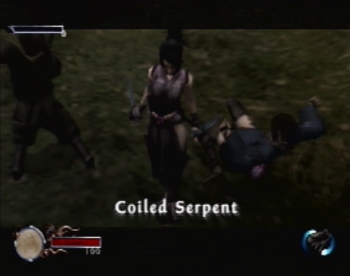
Fatal Shadows allows Rin and Ayame to perform double stealth kills, taking out two enemies at once. However, with rare exception, I think it’s less risky to just do back-to-back indiviual kills and just skip the silly animations.
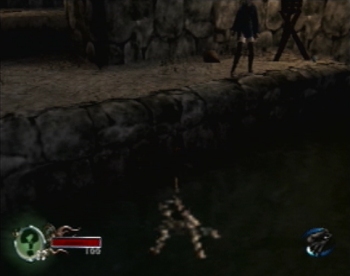
Now that I think about it, Tenchu 2 introduced swimming to the franchise. Even though it was absent in Wrath of Heaven, I honestly did not miss it. Heck, Fatal Shadows only gives you three places to use it, but it is nice that it’s there.
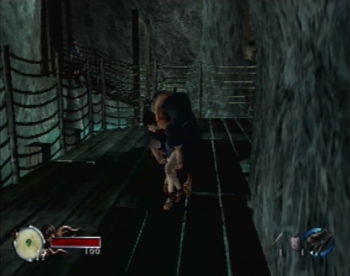
Holding R1+Circle over a corpse will allow you to pick it up and drag it away. Unfortuntely, you can’t throw them over a cliff or lift them up to a higher platform, but at least you can move them, damn it.
Here’s the thing though: if you lose to Ayame—who didn’t want to fight in the first place—you die. Game over. Start the mission over. Never mind the tiny detail that when you played as Ayame in Mission 1, you fought Rin, beat Rin, and in that cutscene Ayame refused to kill Rin. So, why does this fight go to the death? Why can’t it have a timer like the Ranzou battle in Chapter 11 where if you take too long the sick and twisted evil renegade ninja just up and leaves on a whim. So why can’t Ayame, who came here to make peace, quit the fight and make peace? You know what else? When you do beat Ayame, the bad guy who did burn Rin’s village to the ground steps forward and tries to kill Rin. Ayame takes a bullet for her, saves her life, and gets captured. So, again, why was Ayame out to kill Rin thirty seconds ago? Never mind. Plot logic is the least of this mission’s problems. Fighting Ayame can be pretty tough especially if you don’t know what you’re doing. And you won’t know what you’re doing because this is Rin’s first boss fight. In other words, if you’ve played the game correctly up until this point, sneaking up on enemies and stealth killing them from the shadows, Chapter 6 is the first time you’ve test driven Rin’s skills in combat. And I suspect the game designers knew considering they included a hidden path at the very beginning of the stage that skips directly to Ayame. And it gets worse. After beating the Azuma and exploring the second half of the level, you come to Nasu, the hardest fight in the game—not because Nasu is particularly difficult by himself, rather because you fight him in a fucking closet. You can’t dodge because there’s not enough room to avoid his six hit combo, and you can’t stand still and block because he has not one but two unblockable attacks that are too fast to react to (not that you have space to react). He swings his sword in weird exaggerated arcs and he links them together in awkwardly timed combos where he can stop after any hit so you never know if he’s finished or if the rest of the combo is coming which makes him the hardest enemy to read thus the hardest to parry. Let’s not forget at this point in Story Mode, you haven’t unlocked all the ninja abilities nor have you unlocked all items. Grenades or smoke bombs will make short work of him, but really? Why do I have to waste precious resources on a fat perverted hunchback off the streets? It’s not that I can’t beat Nasu, it’s that he should not be this difficult. He should not be harder than Shinogi, the battle hardened assassin who kills for fun in Chapter 7. He should not be harder than the assassin horde Ayame faces at the start of Chapter 9. And he certainly should not be harder than the final boss, Jyuzou, whose entire offensive game I can counter with a 100% success rate. Nasu is a nobody. You should be able to take him down with one hit like Jyuzou’s secret mistress in Chapter 3. At the very least you should fight him in a room that doesn’t cripple you. Once again, I suspect the developers knew how screwed up this is because not only can you skip the first half of Mission 6, but you can bypass most of the guards in the second half. Furthermore, you can skip fighting Nasu altogether and have Rin kill him in a cutscene. Now, I like the idea of having multiple routes—choices—that actually impact the gameplay. I’m all for it. I wish there was more of it. But choices don’t feel like choices when one of them flirts with suicide and, again, there’s no justification for making random closet scumbag the hardest battle in the game. Like Wrath of Heaven, successful stealth kills lead to new ninja abilities, but Fatal Shadows complicates a perfectly functional simple mechanic by forcing you to collect scrolls which the stealth killed enemies now drop. Scrolls which go away after a set period of time. Furthermore, Fatal Shadows attempts to inject an interactive element into the preset stealth kill animation by allowing you to press Square (attack) on the death blow which awards additional scrolls. But the appeal of Tenchu lies in the long reaching process of finding targets, observing their patrols/behavior, developing an attack plan, and executing it with precision and speed. I really don’t care about collecting disappearing scrolls. Given the harder enemy placement and their increased likelyhood to suddenly turn around, I’d rather skip the animation, leave the scroll, and move on to my next prey (especially now that I’ve unlocked everything, rendering the scrolls useless.) 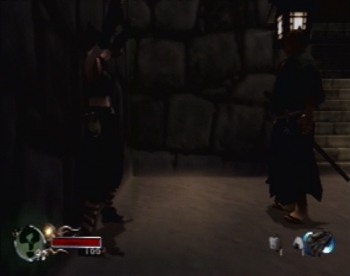
This is just as silly as it looks. When her back is to the wall, Ayame can hold up a canvass that magically matches her surroundings. At least she’s locked into place and guards can still spot her from the right angles so it’s not quite as bad as Rin’s invisibility.
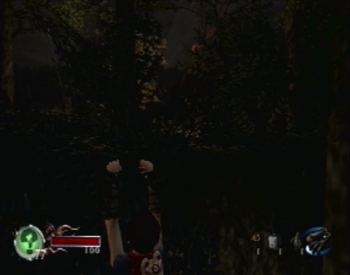
Since the camera hovers behind your character, the foliage actually obscures your view more than it should and when coupled with your inability to reach up and push a branch out of the way, sometimes you can’t see a damn thing.
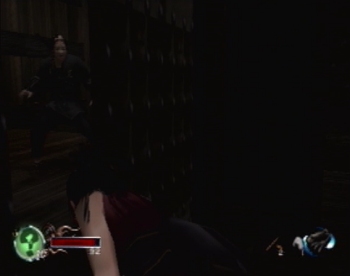
Yes! Holding R1 (stealth mode) and approaching a door allows you to peek through without fear of getting spotted.
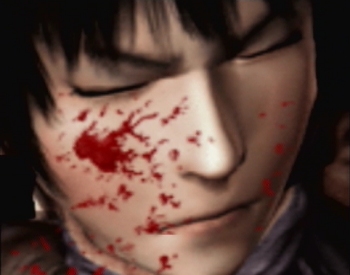
Crimson Final is kinda like playing that old game Dragon’s Lair: wait for the right animation and perform the next input. And considering there's only three things to do, it’s stupidly easy for the ridiculous damage it does.
Fatal Shadows provides a few tools to deal with the increased difficulty, but they’re not as reliable as I would like. Now you can stealth kill two enemies at once, allowing you to dispatch the many pairs and triplets of guards who patrol a small area. Several missions even feature two enemies conversing. Unfortunately, since Fatal Shadows takes after its predecessor with proximity dictating the fine print of every interaction, sometimes you won’t be close enough to both enemies to trigger the double kill; instead you’ll get a single stealth kill and more than likely end up spotted. Another useful update from earlier Tenchus (that was curiously absent in Wrath of Heaven): when enemies think they’ve seen something (a “!” on the Ki meter) they’ll walk over to investigate which allows you to lure them away before dispatching them. But sometimes you’ll be in stealth mode, slowly easing your way up one cautious step at a time, expecting your target to go from oblivious (“?”) to suspicious (“!”), and instead they jump directly to full alert (“!!”) and come after you. So, despite all the improvements and new tricks, Fatal Shadows still gives the highest percentage of scenarios where you end up spotted on account of unpredictable (sometimes unavoidable) BS. I have the most fun when I can start a level blind and work through it—discovering all the guards, sneaking up on them, and slaying them—all in a single try. In that sense, I consider Tenchu more of an exploration game whose premise really makes me want to immerse myself into the world where I can look around, seek, then destroy. Fatal Shadows, though, requires perfect execution in an environment with flaky camera and proximity issues which translates to trial and error which translates to memorizing the map which makes it feel like an arcade game. Put in another quarter and try again. Which is fine for Pac-Man, Afterburner, or Final Fight (all great), but it takes away from the stealth experience. Making matters worse, some Missions feature two variations. Theoretically, branching missions could lead to interesting developments that open up certain items, paths, and cutscenes while closing off others, giving the world a sense of logical cause and effect—making the world more believable—but the only mission that remotely comes close is 7-2 which offers Ayame a shortcut because she acquired the map. But that’s the exception, and not the rule. For the most part, one version of a mission plays like every other Tenchu level while the second version throws in an additional complication such as having to kill all enemies before the mission ends (2-2), following Jyuzou without getting spotted (3-1), and instant failure for being spotted (6-2)—the latter examples forcing failure after failure, retry after retry, and the exploration element evaporates, replaced by the practiced choreography of something resembling a speedrun. But what really kills Fatal Shadows for me is the abandonment of mysticism and the superficial focus on realism that fails to focus on realism. Not only does Fatal Shadows lose the colorful variety of Tenrai’s sorcery and Amagai Castle in favor of a never ending monotony of guys with swords, but it engages in the hypocrisy that undead are off limits but Rin can turn invisible at will. The game wants to be realistic, but makes a “blind” con artist more powerful than the man wielding a bloody machine gun (a machine gun that never runs out of ammo back in feudal Japan, no less.) It dares me not to believe, and given how much I hate Rin, I’m more than happy to oblige. Improved game mechanics be damned. | ||||||||||||||||||||
|
| ||||||||||||||||||||
